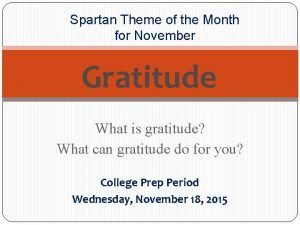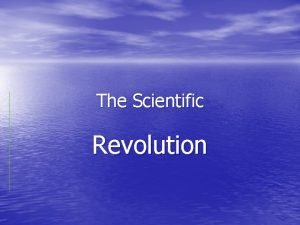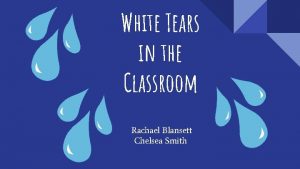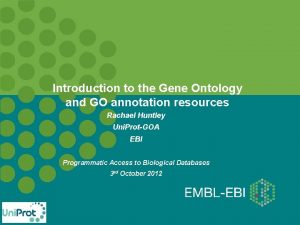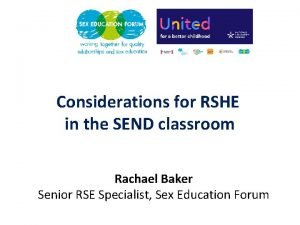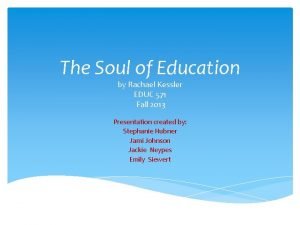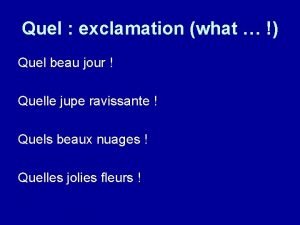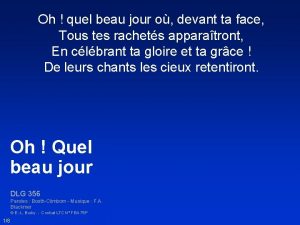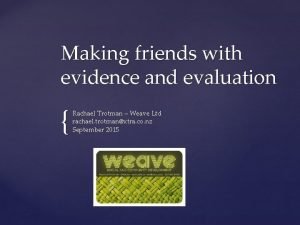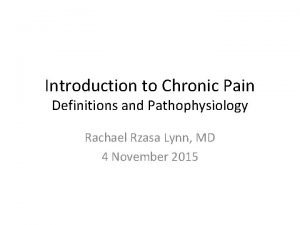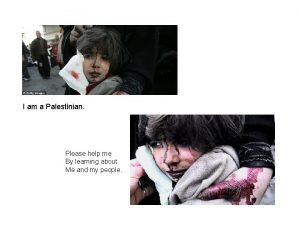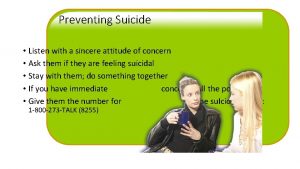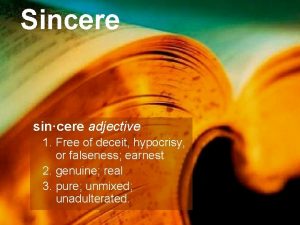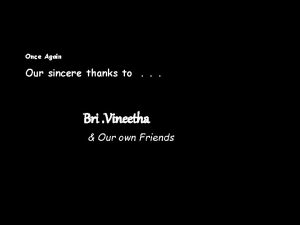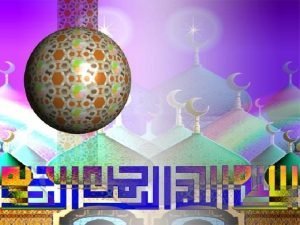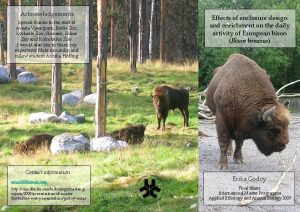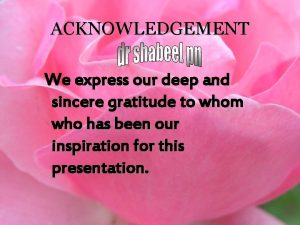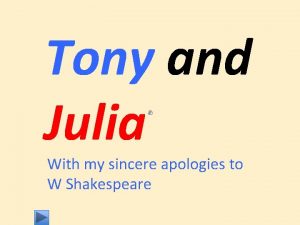Acknowledgements With sincere and grateful thanks to Rachael






















- Slides: 22


Acknowledgements With sincere and grateful thanks to Rachael Symes, Head of Early Years, Australian International School, Singapore, for putting together all the Early Years slides for Global Be Well Day.

Intent • The intent of the following slides, is for the suggested activities and the ‘why’ behind offering Early Years children these experiences, to be used as a resource for Cognita Early Years Educators. • The ‘why’ is to help keep our parent body informed of the benefits of having a holistic and balanced educational approach to ensure the ongoing and long term benefits of mental and physical well-being. Research shows that the single most important factor in education is the Early Childhood Educator. “The Early Childhood Educator is the secret to the prosperity of society. The opportunity that the educator has to lay the trajectory to a child’s pathway is huge. ” Dr Stuart Shanker

The 100 Languages - (Reggio inspired approach) Imagine believing that children have the ability to express themselves in more than one way. Now times that by 100! Loris Malaguzzi, founder of the Reggio Approach, describes the "infinite ways that children can express, explore, and connect their thoughts, feelings and imaginings. " These languages (the Hundred Languages of Children) are symbolic and are open to the endless potentials in children. They believe in the potential of a child's ability to wonder. It is the belief that there are "multiple ways of seeing and multiple ways of being. "

GBWD linked to Unit of Inquiry: How We Express Ourselves Transdisciplinary Theme An inquiry into the ways in which we discover and express ideas, feelings, nature, culture, beliefs and values; the ways in which we reflect on, extend and enjoy our creativity; our appreciation of the aesthetics. Central ideas for our programs for 3 and 4 year old children • Creatively using tools and materials helps people to express their ideas and feelings • Exploring and using a variety of materials to be creative (honouring the 100 languages of children)


Sensory Experiences (The Brain) From birth to early childhood, children use their five senses to explore and try to make sense of the world around them. It’s an important part of early childhood development, and providing opportunities for children to actively use their senses as they explore their world through ‘sensory play’ is crucial to brain development. Sensory activities also allow children to refine their thresholds for different sensory information, helping their brain to create stronger connections to sensory information and learn which are useful and which can be filtered out. Other reasons sensory play is beneficial for children include: • It helps to build nerve connections in the brain • It encourages the development of motor skills • It supports language development • It encourages ‘scientific thinking’ and problem solving • It can involve mindful activities which are beneficial for all children The desire to engage with sensory play comes naturally for children and should be encouraged and supported both at home and in early learning environments.

Sensory Experiences Activity: Spice Sensation • Have a variety of spices for children to smell and provide different tools for the children to blend the spices Mortar and Pestle

Sensory Experiences Where do I see colours? • Having a variety of fruits/ vegetables/ spices/ tea bags/ coffee pods/ vanilla pods / essential oils for the children to extract the colours and make their own playdough. • The kneading process will help them relax their minds and essential oils could be used to add the element of smell.

Sensory Experiences - smell Activity: Orange Garlands • Having a selection of dried oranges/ bay leaves/ cinnamon sticks/ beads and string. • The children will get an opportunity to touch/ smell and feel the spices and citrus fruits before they begin the threading activity.

Sensory Experiences - In art we trust Activity: Feely wall or alternatively create feely boxes • Children place their hands through the wall and are guided to create a piece of art. Examples on next slide

Sensory Experiences - In art we trust 1. Molding air drying clay into an art piece 2. Tie dyed material art, using scraps of calico and eye drops to squirt water colours 3. Rainbow sand art Pouring coloured sand into small jars

Sensory Experiences - water troughs Activity: Water troughs • Setting up water troughs with coloured water/ citrus fruits/ giant ice cubes/ water baby beads. Have a selection of strainers/ spoons/ hand beaters/ whisks. • Inviting the children to use the tools to scoop out the materials, and to feel the different textures, and temperatures of the water.

Sensory Experiences - Ice play • Having a table setup with frozen fruits/ flowers/ plastic animals/ brushes/ wooden tools/ and salt. • Invite the children to use the tools to extract the flowers/ fruits/ animals using water and salt. Note that when we give them time to work on their theories, they feel empowered.

Sensory Experiences - Flower potions Activity: Providing the children with different coloured flowers, leaves, small bottles, spoons, plastic tweezers, magnifying glasses, and coloured water. • Engaging the learners in making their own potions using natural material.

The Brain - infants

Brain Science • The first five years of a child’s life matter as this is when a child’s brain is at its most flexible, making this a critical period for learning and growth. From birth to age five, we see a rapid rate of brain development - 90% of a child’s brain is developed before they even walk into a classroom. • It’s hard to overstate the significance of these early years, and research at Harvard University on brain development shines a light on this very importance, with numbers almost too incredible to believe. • In the first few years of life for example, more than one million new neural connections are formed every second. The process is driven by the interaction of genes and the child’s experiences, and it’s these early connections which build the brain architecture upon which all future learning depends. • The experiences provided to babies and young children all have an impact on how many neural connections are retained, and which ones are strongly developed, as they grow older. • All experiences – positive and negative, stimulation and neglect – play a significant role in the future of every child.

The Brain • Understanding the different parts of the brain • Brain training games/activities focussed on developing different parts of the brain • Documentation for parents to be centred around understanding different parts of the brain and how these can be supported/worked through early childhood activities offered in classrooms • Using resources; ‘ The Elastic Brain’ (children’s book) and ‘The Whole Brain Child’ (text reference book) • Website resource; https: //blissfulkids. com/mindfulness-and-the-brain-how-to-explain-itto-children/

The Brain: Smart Steps programme The Smart Steps approach • The Smart Steps program forms a fundamental part of the Early Years curriculum at the Australian International School. The program offers a well-balanced mix of activities designed to develop ‘automaticity’, making movement something which children do not have to think about. When a child automates control of their physical self, their brain can turn to other matters, such as thinking and reasoning, creativity and invention, and strategies and tactics they will use in the classroom, on the playing field or in any other endeavor they choose to pursue. In other words, developing a smart relationship between the body and the brain makes everything else possible. The Smart Steps activities • The Smart steps activities are developed around six basic elements of movement – the senses, balance, intuition, power, coordination and control, all of which are underpinned by the development of language. There a total of 50 different activities in the program and these range from tunneling to improve spatial awareness, walking on beams to improve balance and juggling bean bags to improve coordination.

The Brain: Smart Steps obstacle course Activity: Tunnels / parachutes / sliding mats / bean bags • Setting up an obstacle course which will challenge the children with their senses, balance, intuition, power, coordination and control.

Brain breaks for adults and children • Having a poster of ‘brain breaks’ in the classroom and the staff rooms will help the children and adults focus more on their mental wellbeing. The children could select an break that they would like to have such as dancing or taking deep belly breaths.

 I come before you today
I come before you today Grateful grabber
Grateful grabber What is gratitude
What is gratitude With sincere heart and unpretended faith
With sincere heart and unpretended faith Rachael blansett
Rachael blansett Rachael huntley
Rachael huntley Rachael blansett
Rachael blansett Rachael kessler
Rachael kessler Rachael edgerly
Rachael edgerly Rachael hale
Rachael hale Rachael hale
Rachael hale Rachel trotman
Rachel trotman Rachael hale
Rachael hale Rachael
Rachael Tom hurndall
Tom hurndall Rachael drazan malmberg
Rachael drazan malmberg Medtronic organizational chart
Medtronic organizational chart Sincere brief seated
Sincere brief seated Characteristics of a sincere person
Characteristics of a sincere person Sincere effort
Sincere effort Sincere attitude
Sincere attitude Give thanks to the lord our god and king
Give thanks to the lord our god and king Alleluia alleluia give thanks to the risen lord lyrics
Alleluia alleluia give thanks to the risen lord lyrics


